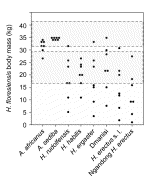Stephen H. Montgomery
Source - http://www.sciencedirect.com/science/article/pii/S0047248413002029
Journal of Human Evolution: Volume 65, Issue 6, December 2013, Pages 750–760
Abstract
The taxonomic status of the small bodied hominin, Homo floresiensis, remains controversial. One contentious aspect of the debate concerns the small brain size estimated for specimen LB1 (Liang Bua 1). Based on intraspecific mammalian allometric relationships between brain and body size, it has been argued that the brain of LB1 is too small for its body mass and is therefore likely to be pathological. The relevance and general applicability of these scaling rules has, however, been challenged, and it is not known whether highly encephalized primates adapt to insular habitats in a consistent manner. Here, an analysis of brain and body size evolution in seven extant insular primates reveals that although insular primates follow the ‘island rule’, having consistently reduced body masses compared with their mainland relatives, neither brain mass nor relative brain size follow similar patterns, contrary to expectations that energetic constraints will favour decreased relative brain size. Brain:body scaling relationships previously used to assess the plausibility of dwarfism in H. floresiensis tend to underestimate body masses of insular primates. In contrast, under a number of phylogenetic scenarios, the evolution of brain and body mass in H. floresiensis is consistent with patterns observed in other insular primates.

Figure 1.
Estimated body masses for H. floresiensis using the brain:body scaling relationship from each mainland/island primate pair. The range of estimates is shown for each assumed ancestor, given along the x-axis. The lower grey box gives the range of body mass estimates for LB1 derived from femoral cross-sectional area, the upper grey box gives the range derived from the femoral head diameter .